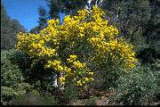|
[Front Page] [Features] [Departments] [SGAP Home Page] [Subscribe]

Australian Floral Emblems - Acacia pycnantha
The Acacia is the most common plant found in Australia. There are over 700 Australian species, more than that of the other Australian floral icon, the Eucalypt. It's appropriate then that an Acacia (or "wattle" as the genus is collectively known in Australia) should be adopted as the national floral emblem. Surprisingly, though, an official floral emblem was not declared until 1988, in time for the Bicentennial of European settlement.

Acacia pycnantha forms a colourful small tree or large shrub. Select the thumbnail image or plant name for a higher resolution image (36k).
(Photo courtesy of the National Botanic Gardens)
Acacia pycnantha, the "Golden Wattle" was the unofficial floral emblem for many years before being made "legitimate" in 1988. It was first collected in the 1830s by Surveyor-General Thomas Mitchell during exploration in southern New South Wales and it was described botanically by George Bentham in 1842. The species is found naturally in three Australian states (New South Wales, Victoria and South Australia) and is grown widely elsewhere. The following description is from the Society's 1977 publication "Acacias of New South Wales" by Inez Armitage, a well respected authority on the genus and for many years the leader of the Acacia Study Group (an explanation of some of the botanical terms used is given in the footnote).
DESCRIPTION: A small to medium tree, quite glabrous. Branchlets almost terete.
Phyllodes thick and leathery, with great variation in shape and width, 8-20 cm x 10-50 mm,
lanceolate-falcate to almost ovate, with a strong central vein and distinct penniveining. Glands are also very variable, sometimes one below the halfway mark or very near the base, usually very prominent but sometimes quite small or even absent. Less frequently two glands are present, usually widely spaced on the upper margin. Peduncles medium length, thick and glabrous. Flowerheads large, brilliant golden yellow, 60-80 flowers per head. Racemes about as long as phyllodes. Pod straight or slightly curved, 5-14 cm x 5-8 mm, flat and rather thin.
Flowering: Spring.
|
Acacia pycnantha is easily propagated from seed after pretreatment by soaking in boiling water and allowing to stand overnight. Seed which has swollen can then be sown by normal seed raising methods. Unswollen seed should be pretreated again. Some success has also been reported with propagation by cuttings.

The Colourful flowers of The Golden Wattle show clearly against the deep green foliage. Select the thumbnail image or plant name for a higher resolution image (21k).
(Photo courtesy of the National Botanic Gardens)
In the garden, the plant is quick growing and will often flower in the second season after sowing. It will tolerate a wide range of soils but should be grown in a well drained situation in sun or partial shade. It can be grown in coastal districts but is best away from front line exposure to salt spray.
The bark of A.pycnantha has been used in the tanning industry.
Unfortunately, like many plants introduced to areas where there are no natural predators, A.pycnantha (and a number of other Acacias) has reportedly become a weed species in South Africa. It has also naturalised in the NSW Tablelands and in Tasmania.
Notes on botanical terms:
- Falcate - sickle shaped
- Glabrous - without hairs
- Gland - small structure which secretes oils or nectar
- Lanceolate - narrow and tapering at each end
- Ovate - egg shaped in longitudinal section with the widest part at the bottom
- Peduncle - flower stalk
- Penniveining - many veins arising from a central axis
- Phyllode - flattened leaf stalk with a leaf-like appearance
- Pod - the structure containing the seeds
- Raceme - a cluster of flowers with the youngest at the apex
- Terete - round in section
The photographs used in this article are part of the excellent "Wattles in the Gardens" presentation produced by the Australian National Botanic Gardens. The site includes descriptions and photographs of 100 Acacia species.
 [Front Page] [Features] [Departments] [SGAP Home Page] [Subscribe]
[Front Page] [Features] [Departments] [SGAP Home Page] [Subscribe]
The Society for Growing Australian Plantsu
|